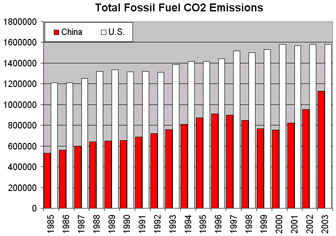Industrialized countries outsource CO2 emissions to China
Industrialized countries outsource CO2 emissions to China
mongabay.com
June 2, 2007
Facing criticism as it surpasses the U.S. as the world’s largest producer of carbon dioxide, China says that industrialized countries are hypocritical for criticizing its greenhouse gas emissions while buying its products, according to the Associated Press. China argues that developed countries are effectively outsourcing emissions by shifting manufacturing to its factories,
“The developed countries move a lot of manufacturing industry into China. A lot of the things you wear, you use, you eat are produced in China,” Foreign Ministry spokesman Qin Gang is quoted a saying by the A.P. at a news briefing. “On the one hand, you shall increase the production in China, on the other hand you criticize China on the emission reduction issue.”
China became the world’s largest emitter of CO2 in 2006 according to analysis by the Netherlands Environmental Assessment Agency (EEA), a group that advises the Dutch government. China produced 6,200 million metric tons of carbon dioxide last year, compared with 5,800 million tons for U.S. CO2 emissions in China are now 7.5 percent higher than in America, whereas last year China’s emissions lagged 2 percent behind those of the U.S., which faces a slowing economy.
 Carbon dioxide emissions from fossil fuels for the U.S. and China, 1985-2003. Data from EIA. |
While China now tops the U.S. in emissions, per capita emissions in China are less than one-quarter of those in the United States. China emits 10,500 pounds of carbon dioxide per person, while in the United States producers nearly 42,500 pounds per person
China’s emissions are expected to continue growing swiftly in the future due to the country’s heavy reliance on coal, a plentiful resource in the country. However, with rising levels of pollution, the government is keen on developing cleaner coal technologies as well as renewable energy sources like solar, tidal, and biomass. Chinese firms have recently invested billions in biofuel crops and infrastructure in Indonesia and the Amazon.
While China has balked on calls to limit its greenhouse gas emissions, earlier this month it announced its first climate change initiative. According to state media, the National Climate Change Program plan calls for China to reduce energy use 20 percent by 2010, promote carbon sink technologies and other adaptive technologies, raise the efficiency of coal-fired power plants, and increase the amount of renewable energy it produces.
The United States has no such plan.